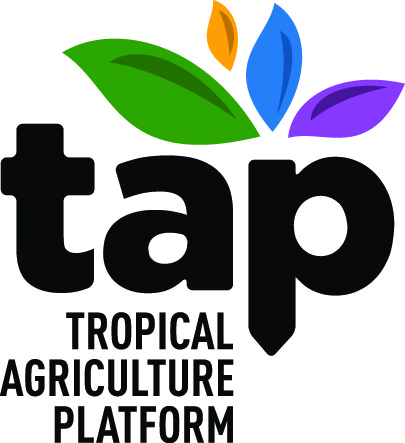Résultats de la recherche
Displaying 351 - 360 of 400 results.
Fortalecimiento de las capacidades de gestión del desarrollo rural a través de los Consejos Municipales de Desarrollo Rural
El documento se divide en cuatro capítulos, el primero contempla un marco de referencia para contextualizar las prácticas en España y la situación en Colombia y el marco conceptual con algunos de los términos más representativos trabajados en el proyecto. En el segundo capítulo se describe el modelo de acompañamiento al CMDR y las respectivas etapas de implementación. El tercer capítulo brinda herramientas para acompañar los procesos de fortalecimiento del CMDR en los diferentes territorios a nivel departamental y nacional.
Sujet(s):
Année de publication:
2019Guía para el fortalecimiento de las capacidades funcionales para la innovación en la agricultura
TAP-related resource
La publicación “Guía para el fortalecimiento de las capacidades funcionales para la innovación en la agricultura” fue desarollada por la Organización de las Naciones Unidas para la Agricultura y la Alimentación (FAO) y el Instituto Interamericano de Cooperación para la Agricultura (IICA) con el apoyo de la Red Latinoamericana de Servicios de Extensión Rural (RELASER) y la Plataforma de Agricultura Tropical (TAP). El propósito de esta guía es contribuir al desarrollo de las capacidades funcionales entre individuos y organizaciones que apoyan la innovación en América Latina.
Sujet(s):
renforcement des capacités (RC)facilitationsystèmes d'innovationinnovationsuivi et évaluation (S&E)processus multipartitesréseau...
Année de publication:
2022Innovation Strategy
The IFAD Innovation Strategy does not set new objectives for staff, but rather defines what is needed to create an innovation-friendly environment and to support staff in achieving the expected results.To strengthen its innovative capabilities and become a better catalyst of pro-poor innovation, IFAD will focus on four clusters of activities: (i) Building capabilities and understanding of challenges requiring innovation; (ii) Nurturing partnerships and facilitating an innovation network; (iii) Embedding rigorous innovation processes and the related risk management into IFAD’s core business
Sujet(s):
renforcement des capacités (RC)facilitationsystèmes d'innovationinnovationsystèmes de connaissances et d'informationKnowledge management/Gestion des connaissancesréseauapproches participativespolitiquesrechercherecherche et développement (R & D)développement ruralchaînes de valeurPetits agriculteurs...
Année de publication:
2007Advances in knowledge brokering in the agricultural sector: Towards innovation system facilitation
The process of knowledge brokering in the agricultural sector, where it is generally called agricultural extension, has been studied since the 1950s. While agricultural extension initially employed research push models, it gradually moved towards research pull and collaborative research models. The current agricultural innovation systems perspective goes beyond seeing research as the main input to change and innovation, and recognises that innovation emerges from the complex interactions among multiple actors and is about fostering combined technical, social and institutional change.
Sujet(s):
courtagerenforcement des capacités (RC)vulgarisationfacilitationsystèmes d'innovationinnovationsystèmes de connaissances et d'informationKnowledge management/Gestion des connaissancesapprentissagerecherche...
Année de publication:
2012Assessment of current capacities and needs for Institutional and individual Capacity Development in Agricultural Innovation Systems. Regional Synthesis Report for Africa
TAP-related resource
TAP and its partners carried out regional surveys in Asia, Africa and Central America to assess priorities, capacities and needs in national agricultural innovation systems. This document provides a Regional synthesis report on capacity needs assessment for agricultural innovation in Africa. FARA was selected as Recipient Organization by FAO to facilitate TAP implementation in Africa. This is mainly due to its position as the umbrella organization bringing together and forming coalitions of major regional stakeholders in agricultural research and development.
Sujet(s):
Service de vulgarisationpromotion/plaidoyercourtagerenforcement des capacités (RC)changement climatiquedocumentationéducationÉcoles pratiques d'agriculture (FFS)vulgarisationfacilitationsécurité alimentaire et nutritionnelleévaluation de l'impactsystèmes d'innovationinnovationplates-formes d'innovationsystèmes de connaissances et d'informationTIC (Technologies de l'information et de la communication)Knowledge management/Gestion des connaissancesapprentissageprocessus multipartitesévaluation des besoinsréseauapproches participativespolitiquesengagement du secteur privéengagement du secteur publicrechercherecherche et développement (R & D)recherche pour le développement (R4D)développement ruralcoopération Sud-Sudchaînes de valeursecteur agroalimentaire...
Année de publication:
2013Agricultural Knowledge and Innovation Systems Towards the Future
This paper offers a perspective on the Agricultural Knowledge and Innovation System. The first chapter gives an introduction to the subject and explains the role of SCAR and of the Strategic Working Group AKIS. The second chapter investigates the AKIS and their role in innovation, including the policy context of the European Innovation Partnership “Agricultural productivity and sustainability”. Chapter 3 discusses the relation in a globalised world between Agricultural Research (AR) and Agricultural Research for Development (ARD).
Sujet(s):
Service de vulgarisationConcepts au sujet de RCOutils au sujet de RCfacilitationinnovationTIC (Technologies de l'information et de la communication)Knowledge management/Gestion des connaissancesapprentissageprocessus multipartitesréseauapproches participativespolitiquesrechercherecherche et développement (R & D)secteur agroalimentaire...
Année de publication:
2016Communication for Rural Innovation: Rethinking Agricultural Extension (Third Edition)
This book is the re-titled third edition of the widely used Agricultural Extension (van den Ban & Hawkins, 1988, 1996). Building on the previous editions,Communication for Rural Innovation maintains and adapts the insights and conceptual models of value today, while reflecting many new ideas, angles and modes of thinking concerning how agricultural extension is taught and carried through today.
Sujet(s):
Service de vulgarisationcourtagerenforcement des capacités (RC)Concepts au sujet de RCcommunicationvulgarisationfacilitationsystèmes d'exploitation agricolesécurité alimentaire et nutritionnelleévaluation de l'impactinnovationsystèmes de connaissances et d'informationTIC (Technologies de l'information et de la communication)Knowledge management/Gestion des connaissancesapprentissagesuivi et évaluation (S&E)négociationréseauapproches participativespolitiquesengagement du secteur privéengagement du secteur publicagriculture durablechaînes de valeur...
Année de publication:
2007An analysis of power dynamics within innovation platforms for natural resource management
One option for practically applying innovation systems thinking involves the establishment of innovation platforms (IPs). Such platforms are designed to bring together a variety of different stakeholders to exchange knowledge and resources and take action to solve common problems. Yet relatively little is known about how IPs operate in practice, particularly how power dynamics influence platform processes.This paper focuses on a research-for-development project in the Ethiopian highlands which established three IPs for improved natural resource management.
Sujet(s):
renforcement des capacités (RC)communicationvulgarisationfacilitationsystèmes d'exploitation agricolesystèmes d'innovationinnovationplates-formes d'innovationKnowledge management/Gestion des connaissancesapprentissageprocessus multipartitesnégociationréseauapproches participativespolitiquesrechercherecherche pour le développement (R4D)systèmes de rechercheRecherche en systèmesdéveloppement ruralchaînes de valeurPetits agriculteurs...
Année de publication:
2014New Knowledge Networks of Small-Scale Farmers in Europe’s Periphery
In this paper, presented at the 12th European IFSA Symposium (Workshop: "Generating spaces for innovation in agricultural and rural development") in 2016, the authors assess the integration of new entrants to small-scale farming into agricultural knowledge and innovation systems (AKIS), in four study sites located on Europe’s periphery (Bulgaria, Poland, Portugal, and the United Kingdom).
Sujet(s):
Service de vulgarisationcourtagerenforcement des capacités (RC)communicationéducationvulgarisationfacilitationsystèmes d'innovationinnovationsystèmes de connaissances et d'informationKnowledge management/Gestion des connaissancesConnaissance localeapprentissageprocessus multipartitesréseaurecherchedéveloppement ruralsecteur agroalimentairePetits agriculteurs...
Année de publication:
2016Stimulating innovation opportunities through shared and unique connections of intermediaries within advisory networks
While privatization of extension has received considerable attention with respect to implications for public and private good, less consideration has been given to structural and relational implications for knowledge sharing.
Sujet(s):
promotion/plaidoyercourtageéducationvulgarisationfacilitationinnovationKnowledge management/Gestion des connaissancesapprentissageprocessus multipartitesréseauengagement du secteur privéengagement du secteur publicrecherchedéveloppement ruralsecteur agroalimentaire...
Année de publication:
2016Pages
Sorting block
Filtrer par idiome
Filtrer par sujet(s)
- (-) Remove facilitation filter facilitationfacilitation
- facilitation (54) Apply facilitation filter facilitation
- facilitation (27) Apply facilitation filter facilitation
- facilitation (46) Apply facilitation filter facilitation
- facilitation (347) Apply facilitation filter facilitation
- facilitation (33) Apply facilitation filter facilitation
- facilitation (90) Apply facilitation filter facilitation
- facilitation (28) Apply facilitation filter facilitation
- facilitation (96) Apply facilitation filter facilitation
- facilitation (101) Apply facilitation filter facilitation
- facilitation (58) Apply facilitation filter facilitation
- facilitation (76) Apply facilitation filter facilitation
- facilitation (49) Apply facilitation filter facilitation
- facilitation (22) Apply facilitation filter facilitation
- facilitation (310) Apply facilitation filter facilitation
- facilitation (127) Apply facilitation filter facilitation
- facilitation (171) Apply facilitation filter facilitation
- facilitation (80) Apply facilitation filter facilitation
- facilitation (154) Apply facilitation filter facilitation
- facilitation (57) Apply facilitation filter facilitation
- facilitation (47) Apply facilitation filter facilitation
- facilitation (119) Apply facilitation filter facilitation
- facilitation (121) Apply facilitation filter facilitation
- facilitation (113) Apply facilitation filter facilitation
- facilitation (83) Apply facilitation filter facilitation
- facilitation (92) Apply facilitation filter facilitation
- facilitation (128) Apply facilitation filter facilitation
- facilitation (104) Apply facilitation filter facilitation
- facilitation (71) Apply facilitation filter facilitation
- facilitation (189) Apply facilitation filter facilitation
Filtrer par auteur(s)
- facilitation (3) Apply facilitation filter facilitation
- facilitation (40) Apply facilitation filter facilitation
- facilitation (3) Apply facilitation filter facilitation
- facilitation (22) Apply facilitation filter facilitation
- facilitation (2) Apply facilitation filter facilitation
- facilitation (7) Apply facilitation filter facilitation
- facilitation (3) Apply facilitation filter facilitation
- facilitation (2) Apply facilitation filter facilitation
- facilitation (5) Apply facilitation filter facilitation
- facilitation (5) Apply facilitation filter facilitation
- facilitation (2) Apply facilitation filter facilitation
- facilitation (2) Apply facilitation filter facilitation
- facilitation (11) Apply facilitation filter facilitation
- facilitation (23) Apply facilitation filter facilitation
- facilitation (20) Apply facilitation filter facilitation
- facilitation (2) Apply facilitation filter facilitation
- facilitation (6) Apply facilitation filter facilitation
- facilitation (3) Apply facilitation filter facilitation
- facilitation (3) Apply facilitation filter facilitation
- facilitation (3) Apply facilitation filter facilitation
- facilitation (3) Apply facilitation filter facilitation
- facilitation (3) Apply facilitation filter facilitation
- facilitation (2) Apply facilitation filter facilitation
- facilitation (2) Apply facilitation filter facilitation
- facilitation (6) Apply facilitation filter facilitation
- facilitation (4) Apply facilitation filter facilitation
- facilitation (2) Apply facilitation filter facilitation
- facilitation (7) Apply facilitation filter facilitation
- facilitation (2) Apply facilitation filter facilitation
- facilitation (3) Apply facilitation filter facilitation
- facilitation (3) Apply facilitation filter facilitation
- facilitation (2) Apply facilitation filter facilitation
- facilitation (2) Apply facilitation filter facilitation
- facilitation (2) Apply facilitation filter facilitation
- facilitation (3) Apply facilitation filter facilitation
- facilitation (3) Apply facilitation filter facilitation
- facilitation (4) Apply facilitation filter facilitation
- facilitation (3) Apply facilitation filter facilitation
- facilitation (3) Apply facilitation filter facilitation
- facilitation (3) Apply facilitation filter facilitation
- facilitation (4) Apply facilitation filter facilitation
- facilitation (2) Apply facilitation filter facilitation
- facilitation (3) Apply facilitation filter facilitation
- facilitation (2) Apply facilitation filter facilitation
- facilitation (23) Apply facilitation filter facilitation
- facilitation (2) Apply facilitation filter facilitation
- facilitation (2) Apply facilitation filter facilitation
- facilitation (2) Apply facilitation filter facilitation
- facilitation (4) Apply facilitation filter facilitation
- facilitation (2) Apply facilitation filter facilitation
Filtrer par pays
- (-) Remove Bangladesh filter BangladeshBangladesh
- facilitation (88) Apply facilitation filter facilitation
- facilitation (79) Apply facilitation filter facilitation
- facilitation (76) Apply facilitation filter facilitation
- facilitation (71) Apply facilitation filter facilitation
- facilitation (71) Apply facilitation filter facilitation
- facilitation (67) Apply facilitation filter facilitation
- facilitation (49) Apply facilitation filter facilitation
- facilitation (32) Apply facilitation filter facilitation
- facilitation (24) Apply facilitation filter facilitation
- facilitation (23) Apply facilitation filter facilitation
- facilitation (23) Apply facilitation filter facilitation
- facilitation (22) Apply facilitation filter facilitation
- facilitation (13) Apply facilitation filter facilitation
- facilitation (13) Apply facilitation filter facilitation
- facilitation (13) Apply facilitation filter facilitation
- facilitation (12) Apply facilitation filter facilitation
- facilitation (12) Apply facilitation filter facilitation
- facilitation (12) Apply facilitation filter facilitation
- facilitation (12) Apply facilitation filter facilitation
- facilitation (11) Apply facilitation filter facilitation
- facilitation (11) Apply facilitation filter facilitation
- facilitation (10) Apply facilitation filter facilitation
- facilitation (10) Apply facilitation filter facilitation
- facilitation (10) Apply facilitation filter facilitation
- facilitation (10) Apply facilitation filter facilitation
- facilitation (10) Apply facilitation filter facilitation
- facilitation (9) Apply facilitation filter facilitation
- facilitation (9) Apply facilitation filter facilitation
- facilitation (9) Apply facilitation filter facilitation
- facilitation (9) Apply facilitation filter facilitation
- facilitation (9) Apply facilitation filter facilitation
- facilitation (8) Apply facilitation filter facilitation
- facilitation (8) Apply facilitation filter facilitation
- facilitation (7) Apply facilitation filter facilitation
- facilitation (7) Apply facilitation filter facilitation
- facilitation (7) Apply facilitation filter facilitation
- facilitation (7) Apply facilitation filter facilitation
- facilitation (7) Apply facilitation filter facilitation
- facilitation (7) Apply facilitation filter facilitation
- facilitation (6) Apply facilitation filter facilitation
- facilitation (6) Apply facilitation filter facilitation
- facilitation (6) Apply facilitation filter facilitation
- facilitation (6) Apply facilitation filter facilitation
- facilitation (6) Apply facilitation filter facilitation
- facilitation (6) Apply facilitation filter facilitation
- facilitation (5) Apply facilitation filter facilitation
- facilitation (5) Apply facilitation filter facilitation
- facilitation (5) Apply facilitation filter facilitation
- facilitation (5) Apply facilitation filter facilitation
Filtrer par éditeur(s)
- facilitation (42) Apply facilitation filter facilitation
- facilitation (42) Apply facilitation filter facilitation
- facilitation (23) Apply facilitation filter facilitation
- facilitation (21) Apply facilitation filter facilitation
- facilitation (17) Apply facilitation filter facilitation
- facilitation (14) Apply facilitation filter facilitation
- facilitation (13) Apply facilitation filter facilitation
- facilitation (12) Apply facilitation filter facilitation
- facilitation (11) Apply facilitation filter facilitation
- facilitation (10) Apply facilitation filter facilitation
- facilitation (9) Apply facilitation filter facilitation
- facilitation (9) Apply facilitation filter facilitation
- facilitation (9) Apply facilitation filter facilitation
- facilitation (7) Apply facilitation filter facilitation
- facilitation (5) Apply facilitation filter facilitation
- facilitation (5) Apply facilitation filter facilitation
- facilitation (4) Apply facilitation filter facilitation
- facilitation (4) Apply facilitation filter facilitation
- facilitation (4) Apply facilitation filter facilitation
- facilitation (4) Apply facilitation filter facilitation
- facilitation (3) Apply facilitation filter facilitation
- facilitation (3) Apply facilitation filter facilitation
- facilitation (3) Apply facilitation filter facilitation
- facilitation (3) Apply facilitation filter facilitation
- facilitation (3) Apply facilitation filter facilitation
- facilitation (3) Apply facilitation filter facilitation
- facilitation (3) Apply facilitation filter facilitation
- facilitation (2) Apply facilitation filter facilitation
- facilitation (2) Apply facilitation filter facilitation
- facilitation (2) Apply facilitation filter facilitation
- facilitation (2) Apply facilitation filter facilitation
- facilitation (2) Apply facilitation filter facilitation
- facilitation (2) Apply facilitation filter facilitation
- facilitation (2) Apply facilitation filter facilitation
- facilitation (2) Apply facilitation filter facilitation
- facilitation (2) Apply facilitation filter facilitation
- facilitation (2) Apply facilitation filter facilitation
- facilitation (2) Apply facilitation filter facilitation
- facilitation (2) Apply facilitation filter facilitation
- facilitation (2) Apply facilitation filter facilitation
- facilitation (2) Apply facilitation filter facilitation
- facilitation (2) Apply facilitation filter facilitation
- facilitation (1) Apply facilitation filter facilitation
- facilitation (1) Apply facilitation filter facilitation
- facilitation (1) Apply facilitation filter facilitation
- facilitation (1) Apply facilitation filter facilitation
- facilitation (1) Apply facilitation filter facilitation
- facilitation (1) Apply facilitation filter facilitation
- facilitation (1) Apply facilitation filter facilitation
- facilitation (1) Apply facilitation filter facilitation
Filtrer par region
- facilitation (79) Apply facilitation filter facilitation
- facilitation (76) Apply facilitation filter facilitation
- facilitation (113) Apply facilitation filter facilitation
- facilitation (25) Apply facilitation filter facilitation
- facilitation (8) Apply facilitation filter facilitation
- facilitation (99) Apply facilitation filter facilitation
Filtrer par type
- facilitation (1) Apply facilitation filter facilitation
- facilitation (34) Apply facilitation filter facilitation
- facilitation (8) Apply facilitation filter facilitation
- facilitation (31) Apply facilitation filter facilitation
- facilitation (10) Apply facilitation filter facilitation
- facilitation (2) Apply facilitation filter facilitation
- facilitation (1) Apply facilitation filter facilitation
- facilitation (58) Apply facilitation filter facilitation
- facilitation (34) Apply facilitation filter facilitation
- facilitation (1) Apply facilitation filter facilitation
- facilitation (16) Apply facilitation filter facilitation
- facilitation (3) Apply facilitation filter facilitation
- facilitation (1) Apply facilitation filter facilitation
- facilitation (6) Apply facilitation filter facilitation
- facilitation (6) Apply facilitation filter facilitation
- facilitation (70) Apply facilitation filter facilitation
- facilitation (1) Apply facilitation filter facilitation
- facilitation (2) Apply facilitation filter facilitation
- facilitation (2) Apply facilitation filter facilitation
- facilitation (1) Apply facilitation filter facilitation
- facilitation (4) Apply facilitation filter facilitation
- facilitation (12) Apply facilitation filter facilitation
- facilitation (5) Apply facilitation filter facilitation
- facilitation (72) Apply facilitation filter facilitation
- facilitation (1) Apply facilitation filter facilitation
- facilitation (4) Apply facilitation filter facilitation
- facilitation (14) Apply facilitation filter facilitation
Filtrer par αnnée de publication
- facilitation (1) Apply facilitation filter facilitation
- facilitation (4) Apply facilitation filter facilitation
- facilitation (2) Apply facilitation filter facilitation
- facilitation (2) Apply facilitation filter facilitation
- facilitation (5) Apply facilitation filter facilitation
- facilitation (5) Apply facilitation filter facilitation
- facilitation (6) Apply facilitation filter facilitation
- facilitation (4) Apply facilitation filter facilitation
- facilitation (17) Apply facilitation filter facilitation
- facilitation (17) Apply facilitation filter facilitation
- facilitation (23) Apply facilitation filter facilitation
- facilitation (22) Apply facilitation filter facilitation
- facilitation (19) Apply facilitation filter facilitation
- facilitation (32) Apply facilitation filter facilitation
- facilitation (69) Apply facilitation filter facilitation
- facilitation (54) Apply facilitation filter facilitation
- facilitation (52) Apply facilitation filter facilitation
- facilitation (29) Apply facilitation filter facilitation
- facilitation (22) Apply facilitation filter facilitation
- facilitation (9) Apply facilitation filter facilitation
- facilitation (2) Apply facilitation filter facilitation
- facilitation (2) Apply facilitation filter facilitation
- facilitation (1) Apply facilitation filter facilitation









